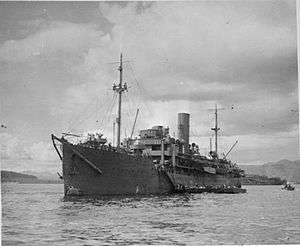HMS Hilary (1940)
HMS Hilary, was a former passenger liner launched in 1931, as SS Hilary, which was requisitioned by the Royal Navy during the Second World War and used as an ocean boarding vessel in the North Atlantic. It was later converted back to a merchantman but subsequently recommissioned back into the Royal Navy as an infantry landing and headquarters ship. At the end of the war in 1945 it was returned to civilian service, and scrapped at Thos W Ward Inverkeithing in 1959.
 HMS Hilary | |
| History | |
|---|---|
| Name: | SS Hilary |
| Owner: | Booth Steamship Company |
| Builder: | Cammell Laird |
| Yard number: | 975 |
| Launched: | 17 April 1931 |
| In service: | August 1931 |
| Fate: | Requisitioned by Royal Navy 1940 |
| Name: | HMS Hilary (F22) |
| Acquired: | 16 October 1940 |
| Commissioned: | 21 January 1941 |
| Out of service: | 15 April 1942 |
| Fate: | Converted back to merchant ship, used as convoy commodore ship. |
| Name: | SS Hilary |
| Owner: | Ministry of War Transport |
| Operator: | Booth Steamship Company |
| Acquired: | 15 April 1942 |
| Out of service: | 1943 |
| Fate: | Recommissioned into Royal Navy as headquarters ship |
| Name: | HMS Hilary |
| Acquired: | 1943 |
| Fate: | Returned to Booth Steamship Company in 1945 |
| History | |
| Name: | SS Hilary |
| Owner: | Booth Steamship Company |
| In service: | March 1946 |
| Fate: | Arrived Inverkeithing for breaking up, 15 September 1959 |
| General characteristics | |
| Displacement: | 7,403 tons gross, 4,350 tons net |
| Length: | 424 ft 3 in |
| Beam: | 56 ft 3 in |
| Draught: | 34 ft 3 in |
| Propulsion: | Triple expansion steam engine and low pressure turbine with direct gearing and hydraulic coupling, single screw |
| Speed: | 14 knots[1] |
| Armament: | two 6 inch guns, one 12 pounder anti-aircraft gun, four .303 machine guns fitted in late 1940.[2] |
History
The ship was constructed to carry 80 first class and 250 second class passengers between the United Kingdom and South America, but was requisitioned in 1940 and refitted in South Shields as an Ocean Boarding Vessel.
Commissioned as HMS Hilary, F22,[2] the ship stopped the Italian tanker, Recco on 3 May 1941 but the crew of the tanker scuttled it before it could be captured. On 10 May Hilary successfully captured the Italian tanker Gianna M.
The ship was returned to civilian service, and acted as a convoy commodore vessel in the North Atlantic. In October 1942 it was torpedoed amidships but the torpedo failed to explode. The following year it was recommissioned as a combined infantry landing ship and headquarters vessel (a Landing Ship Infantry (Headquarters), HMS Hilary, following work at Birkenhead to equip it with six landing craft and accommodation for 313 crew and 378 soldiers.[2]
During the July 1943 invasion of Sicily (Operation Husky), the ship conveyed the 1st Canadian Division and Royal Marine Commandos, and acted as the headquarters ship of Rear Admiral Sir Philip Vian. In October it was Commodore Geoffrey Oliver's headquarters at Operation Avalanche, the invasion of the Italian mainland at Salerno. The ship returned to Portsmouth in December,[1] and was used again in June for Operation Neptune, the invasion of Normandy. Oliver once again used it as his headquarters, this time as commander of Naval Force J, and the ship also led Assault Convoy J11, troops landing from it on 6 June 1944 on Juno beach. Hilary was slightly damaged by a bomb on 13 June and on 23 June became the flagship of the Eastern Task Force because Admiral Vian's original flagship, HMS Scylla, had been put out of action by a mine.[2]
The ship was later returned to its original owners, Booth Steamship Company and returned to civilian service, following refitting to allow 93 first class and 138 third class passengers to be carried between the United Kingdom and South America.[2] It was chartered to Elder Dempster and Company for use on the for their Liverpool - Lagos route but returned to Booth's South America route the following year.[1] The ship was scrapped in 1959.
References
- "Ships Description - H". The Ships List. Archived from the original on 15 September 2008. Retrieved 13 September 2008.
- "Booth Line's R.M.S. "Hilary" 3". Blue Star Line on the web. Retrieved 13 September 2008.
Bibliography
- Osborne, Richard; Spong, Harry & Grover, Tom (2007). Armed Merchant Cruisers 1878–1945. Windsor, UK: World Warship Society. ISBN 978-0-9543310-8-5.
External links
| Wikimedia Commons has media related to HMS Hilary (1931). |